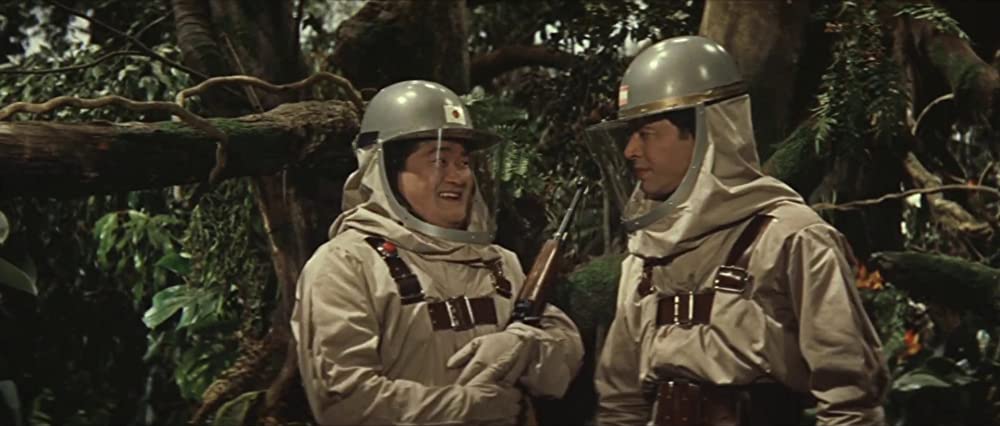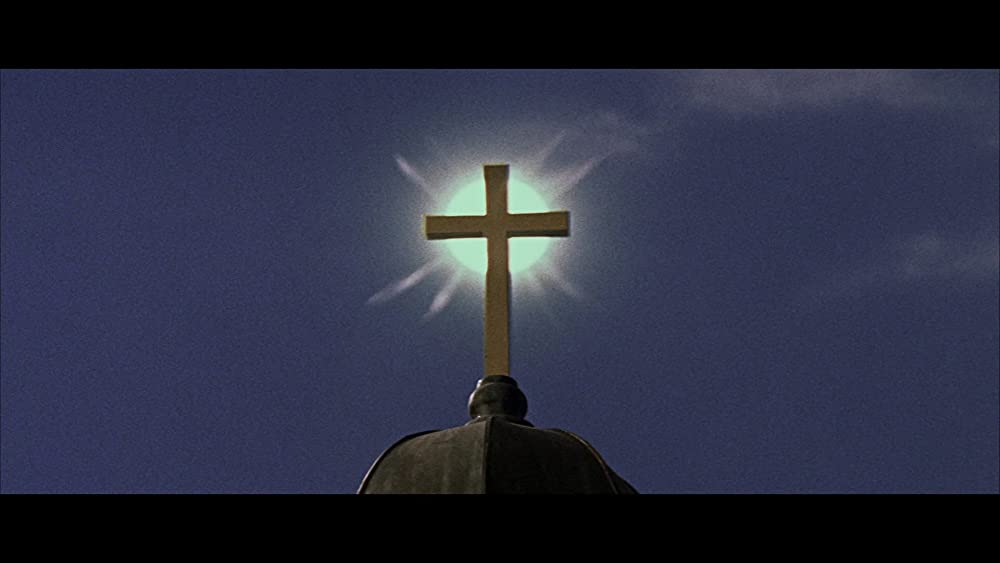
Toho was seven years into the Great Kaiju Project, having produced sombre nuclear disaster stories like Godzilla (or The H-Man) and more traditional prehistoric monster mayhem like Rodan (or Varan), and were really putting in the work to find the next big (BIG!) giant monster film. This involved hiring three authors (Shin’ichirō Nakamura, Takehiko Fukunaga, and Yoshie Hotta) to write a serialized print story that was then given to screenwriter Shinichi Sekizawa (who wrote previous Toho genre projects Varan and Battle In Outer Space, and would write the massive King Kong vs. Godzilla in 1962) to adapt. The story that resulted has the city destruction scenes you’d expect, but otherwise was very different from previous kaiju movies: lighter in tone, more fantastical, and less a grim warning of humanity’s negative impact on this planet than a gentle reminder, and all based around a rather unusual monster (which is also one of the few explicitly female giant monsters.) Sure, there were giant insect movies well before Mothra, but none were this colourful, and certainly none posited that the enlarged arthropod was probably in the right.
Of all the non-Godzilla Toho genre movies, Mothra probably had the largest impact, and its titular lepidopteran would thereon become the company’s second most recognizable creature, appearing frequently alongside the King of the Monsters (Godzilla movies featuring Mothra were often the most well-attended ones in their eras, just to show how much the Japanese audiences dug that bug.) The original movie reflected the changing tone in giant monster movies in the new decade, with subsequent movies often maintaining a similarly lighter touch with much more upbeat endings that allowed the monster to live on—but very few of them have the consistent sense of whimsy that this one does. It really feels like Sekizawa, director Ishiro Honda, and effects maestro Eiji Tsuburaya understood exactly how a movie featuring a giant caterpillar that becomes a giant moth, alongside a duo of tiny singing women, should look and feel, creating something that is a little strange and a little beautiful (and even a little satirical), and one of their most cohesive monster fantasies.

What’s interesting to begin with is the way Mothra starts from a similar place of nuclear anxiety as previous Honda genre movies, but uses it as a launching point for the plot rather than the crux of it. There’s another nuclear test in the South Pacific and another Lucky Dragon 5-style ship, but here the survivors are found, somehow completely unaffected by the radiation. They explain that the natives of the mysterious Infant Island have a way to protect themselves from fallout, which turns out to be the juice from fruit found on their not-terribly-convincing jungle sets (Honda apparently wanted to delve deeper into this aspect of the story, but I think the more vague, magical angle works better for the tone of the movie.) The islanders are, of course, played by Japanese actors in dark makeup, one of those unfortunate, dated aspects that sits awkwardly in a story that is otherwise completely on their side, and is pretty anti-imperialist overall. I imagine that the recurring use of the South Pacific in kaiju media—including King Kong vs. Godzilla, Gamera vs. Barugon, Gappa the Triphibian Monster, episodes of Ultra Q, and Honda’s own Space Amoeba—begins here, most of which have the same racial depiction problems.

The nuclear tests were being conducted by the fictional country of Rolisica, a combination of America and Russia where the military wears Russian-style uniforms but everyone speaks English and lives in American-style cities. Rather more explicitly than previous movies, this is trying to position Japan as a nation having to play clean-up for the Cold War powers (combined into one here), with political machinations used to complicate the plot—the similarities between the situation for the Japanese and the Infant Islanders is pretty clear, even if the movie doesn’t go out of its way to note them. While the Rolisicans do prove to be a hindrance at times, the critique is not entirely mean-spirited, as many of them are shown to be agreeable and work side-by-side with the Japanese, first by sending a joint expedition to Infant Island.

Among those attending are the archaeologist Professor Chujo (Hiroshi Koizumi, previously seen on this site in Dogora), studying the ancient basal language of all Pacific island peoples, and the goofy but tenacious reporter Fukuda (Frankie Sakai), given the nickname “snapping turtle” because he won’t let go of a story. Fukuda is a figure of pure slapstick who successfully bumbles his way through every situation, managing to scam his way onto the expedition crew and later fighting off a half-dozen goons by ducking out of the way and slapping them with a rolled-up newspaper—he’s one of the more likeable protagonists in these kaiju movies, and is the main source of levity even when the city level destruction begins (see him ineptly fumble with his protective sunglasses when an atomic weapon is used.) He is regularly joined by photographer Michi (Kyoko Kagawa, who has appeared in Kurosawa and Ozu movies), who is also resourceful and has developed many sneaky ways to get pictures from uncooperative subjects (like Chujo), and his classically belligerent editor (Takashi Shimura, who played Professor Yamane in Godzilla.) The one heading the expedition is a Rolisican with the placeholder name of Clark Nelson (Japanese-American actor Jerry Ito), a person who gives off bad vibes to Fukuda and Chujo almost immediately (despite apparently being from Rolisica, an investigation into his background states that he is essentially a man without a country, and I wonder if casting a Japanese-American actor was intentonally playing into that idea.) Honda mainstay actors like Akihiko Hirata and Kenji Sahara appear in bit parts, as does future Dogora star Robert Dunham.

While on Infant Island, Chujo and the rest discover two tiny women who speak entirely in electronic noises, who they call the Shobijin, or “small beauties.” They are played by twin sisters Emi and Yumo Ito of The Peanuts, a pop music sensation at the time, and the film readily takes advantage of their talents (as well as the publicity of having them be a central part of the movie.) Nelson and his followers immediately try to take the Shobijin before being warned off by both the islanders and the other members of the crew, and we begin to get a better picture of why Nelson was supporting this endeavour in the first place. Things appear to be friendlier after that, with the Rolisicans promising to halt their tests near Infant Island, but unbeknownst to everyone else, Nelson returns later and successfully kidnaps the Shobijin and massacres a bunch of Infant Islanders in the process. Returning to Japan, he puts the two in a big stage production based around their singing, apparently with the full knowledge of the Rolisican embassy there. This is something that calls for a monstrous intervention, and so both the natives and the Shobijin take part in the song-and-dance ritual that summons their god-monster.

This is, of course, the introduction to the immortal “Song of Mothra”, featured in essentially every movie Mothra appears in, and a generally recognized reference point in Japan and in the western world (if you’re a cool person who watches monster movies.) The lyrics are written in Japanese and translated into Indonesian, probably so it could have a”foreign” sound in all regions (except Indonesia, I guess.) It’s funny to think that in the story, the audience is enjoying a song that is secretly being used to call a giant monster to smash up all their stuff.

There’s many conscious nods to King Kong here, but while Carl Denham was mostly portrayed as misguided, Nelson is a far less scrupulous capitalist exploiter, willing to throw anyone under the bus to keep making his money—he’s one of best human antagonists in the Toho canon, with Jerry Ito giving him a snarling intensity. A little bit more than Kong‘s stage show, too, you could understand why people would go to see these very elaborate revues based around tiny women that the audience could barely see—much like in H-Man, Honda proves himself quite adept at staging musical sequences, and gets even more creative when he intercuts them with scenes of the hatched larval Mothra cruising through the ocean towards Tokyo. As our protagonists discover, the Shobijin can communicate with telepathy, and they explain that Mothra will plow through everything until it finds them, something that not even they can control, giving the plot a greater sense of urgency as well as a sense of natural forces operating outside our grasp. Despite Rolisica protecting Nelson at first, the threat of an angry worm bashing its way through Japan because of something their citizen has done eventually makes it politically inconvenient, and Nelson is forced to retreat to his home country while Mothra busts through a dam, bends Tokyo Tower, and then uses it to hold its cocoon. The Rolisicans offer to help by blasting the cocoon with an “atomic heat ray” (which I can’t imagine would be particularly popular among the Japanese populace), but the fully-formed imago Mothra emerges anyway, cruising through the skies and blowing cars and billboards away with its hurricane-force winds.

Tsuburaya’s miniatures work in this movie is top-notch, and even if the adult Mothra has sort of a scraggly appearance, the puppets and suits are still impressively mobile, with some of the larva suits being seven meters long and operated by five or six actors, including Godzilla suit actors Haruo Nakajima and Katsumi Tezuka (who also portrayed Varan.) Yes, I complained about the more obvious compositing/blue screen shots in Dogora, and those are here too, but this is a better movie, so I had no issue—there remains some potency in the image a gross-looking creature (which is still kind of cute!) emerging as probably the most colourful giant monster anyone had seen up to that point, one of those images that really set kaiju movies apart from other monster movies. After the more expected monster rampage in Japan, we then get to see Tsuburaya’s take on a western urban landscape with Rolisica’s “New Kirk City”, and even aside from the miniatures, there is something fun about seeing a large group of American actors show up in a Japanese monster movie, or to have two priests tell us that they’re “in God’s hands now” vis-à-vis the giant moth situation. Nelson ends up being mobbed by Rolisicans, who all know he’s to blame for said giant moth situation, and he sees the angry faces of the islanders he murdered before being shot by police—there was an alternate ending that was filmed where he tries to escape in a plane and then falls into a volcano(!), and while the one they used is maybe less over-the-top, it feels more appropriate to me. The solution to the problem turns out to be based on the universality of symbols, which Chujo points out, as they paint the cross-like symbol for Mothra from the Infant Island written language on an airport runway and attract it with the sounds of church bells, allowing both bug and Shobijin to go home together in peace.

While the monster scenes are given weight and seriousness, which is something that Honda steadfastly kept to in most of his movies, the atmosphere remains rather buoyant thanks to both the actors and the strange, imaginative visual of Mothra herself. But its message to the audience is what really makes this an appealingly upbeat monster narrative: the similarities between disparate people is emphasized, and despite all those flipped cars and burst dams, the ending remains optimistic that peaceful solutions can be found. While almost the complete opposite to the harrowing and tragic ending to Godzilla, Mothra’s hopeful conclusion still has a power all its own.
